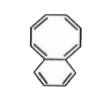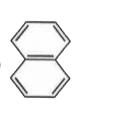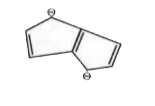Which of the following is a polar molecule ?
Para dichiorobenzene
Carbon tetrachloride
Tetrachloroethene

The correct Answer is:D
To determine which of the given molecules is a polar molecule, we will analyze each option step by step.
Step 1: Analyze para-dichlorobenzene
- Structure: Para-dichlorobenzene has two chlorine atoms attached to a benzene ring at opposite positions (para position).
- Electronegativity: Chlorine is more electronegative than carbon, creating dipoles in the C-Cl bonds.
- Dipole Moment: The dipoles from the two C-Cl bonds are equal in magnitude but opposite in direction. Thus, they cancel each other out.
- Conclusion: Para-dichlorobenzene is a non-polar molecule.
Step 2: Analyze carbon tetrachloride (CCl4)
- Structure: Carbon tetrachloride has a tetrahedral structure with four chlorine atoms surrounding a central carbon atom.
- Electronegativity: Each C-Cl bond has a dipole moment directed towards chlorine.
- Dipole Moment: The symmetrical tetrahedral shape means that the dipoles cancel each other out.
- Conclusion: Carbon tetrachloride is a non-polar molecule.
Step 3: Analyze tetrachloroethene (C2Cl4)
- Structure: Tetrachloroethene has a double bond between two carbon atoms, with two chlorine atoms attached to each carbon.
- Electronegativity: Similar to carbon tetrachloride, each C-Cl bond has a dipole directed towards chlorine.
- Dipole Moment: The symmetrical arrangement of the chlorine atoms means that the dipoles cancel each other out.
- Conclusion: Tetrachloroethene is a non-polar molecule.
Step 4: Analyze para-hydroxy phenol
- Structure: Para-hydroxy phenol has a hydroxyl group (-OH) attached to a benzene ring.
- Electronegativity: The O-H bond has a dipole directed towards oxygen.
- Dipole Moment: The presence of the hydroxyl group introduces an asymmetry in the molecule, and the dipole from the O-H bond does not cancel out with any other dipole.
- Conclusion: Para-hydroxy phenol is a polar molecule.
Final Answer
Based on the analysis, the only polar molecule among the options is para-hydroxy phenol.
---
- Structure: Para-dichlorobenzene has two chlorine atoms attached to a benzene ring at opposite positions (para position).
- Electronegativity: Chlorine is more electronegative than carbon, creating dipoles in the C-Cl bonds.
- Dipole Moment: The dipoles from the two C-Cl bonds are equal in magnitude but opposite in direction. Thus, they cancel each other out.
- Conclusion: Para-dichlorobenzene is a non-polar molecule.
- Structure: Carbon tetrachloride has a tetrahedral structure with four chlorine atoms surrounding a central carbon atom.
- Electronegativity: Each C-Cl bond has a dipole moment directed towards chlorine.
- Dipole Moment: The symmetrical tetrahedral shape means that the dipoles cancel each other out.
- Conclusion: Carbon tetrachloride is a non-polar molecule.
- Structure: Tetrachloroethene has a double bond between two carbon atoms, with two chlorine atoms attached to each carbon.
- Electronegativity: Similar to carbon tetrachloride, each C-Cl bond has a dipole directed towards chlorine.
- Dipole Moment: The symmetrical arrangement of the chlorine atoms means that the dipoles cancel each other out.
- Conclusion: Tetrachloroethene is a non-polar molecule.
- Structure: Para-hydroxy phenol has a hydroxyl group (-OH) attached to a benzene ring.
- Electronegativity: The O-H bond has a dipole directed towards oxygen.
- Dipole Moment: The presence of the hydroxyl group introduces an asymmetry in the molecule, and the dipole from the O-H bond does not cancel out with any other dipole.
- Conclusion: Para-hydroxy phenol is a polar molecule.
Based on the analysis, the only polar molecule among the options is para-hydroxy phenol.
Similar Questions
Knowledge Check
Which of the following is a chiral molecule?
A1-chloro propaneB2-chloro propaneC1-chloro butaneD2-chloro butaneWhich of the following is not a planar molecule?
AH2C=C=CH2BH2C=C=CH2CH2C=C=ODNC−HC=CH−CNWhich of the following is most polar?
A B
B C
C D
D
